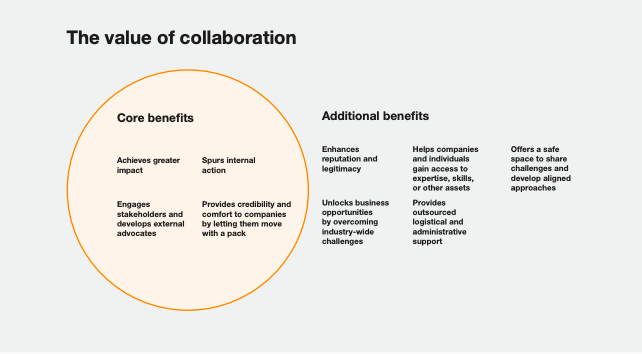Primary Functions
- Learn how to be an effective collaborator and develop a high-level strategy to make progress on the challenges at the forefront of the sustainability agenda.
- Find guidance on managing collaborations via four major lifecycle milestones – Evaluate, Structure, Manage and Conclude.
Detailed Description
Collaboration is increasingly recognized as necessary for making progress on the systemic challenges at the forefront of the sustainability agenda. The desk research, focus groups, and interviews undertaken in developing this report explored the dynamics driving the evolution of company collaboration in and across sectors and highlighted some of the innovative collaboration models that have developed. Our research also led us to create a collaboration life cycle framework to guide sustainability practitioners during development of and participation in effective and impactful collaborations.
Why collaborations are evolving
We identified several factors driving and enabling the evolution of collaborations:
- Stakeholders expect more ambition and transparency from companies, even on topics that companies do not directly control.
- Increasing urgency on sustainability topics is serving as an accelerant.
- Uptake of the United Nations Sustainable Development Goals (SDGs) is enabling cross-sector and multi-stakeholder partnerships.
How collaborations are evolving
As a result of the drivers, corporate engagement in multi-stakeholder initiatives is shifting:
- Companies are being more proactive and strategic with time and resource investments.
- The private sector is overcoming competitive barriers to solve more systemic problems.
- Convening models are diversifying to shape and support more successful collaborations.
How to be an effective collaborator
Develop a collaboration strategy
- Vision — set out a high-level ambition for the company’s collaborations.
- Breadth vs. depth — outline whether the company will focus on a few initiatives or spread itself out across many.
- Type — identify specific models that the company prefers, e.g., peer coalitions or multi-stakeholder groups focused on policy reform.
- Sustainability strategy alignment — ensure focus on material issues and support of company goals.
- Business strategy alignment — lay out how the collaboration strategy supports the overall business goals.

Read more here.





